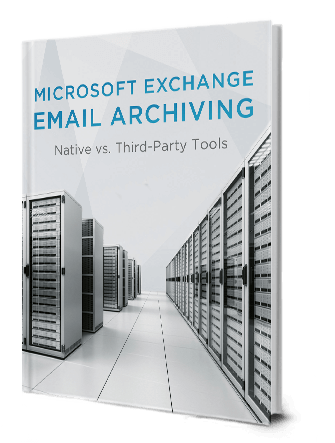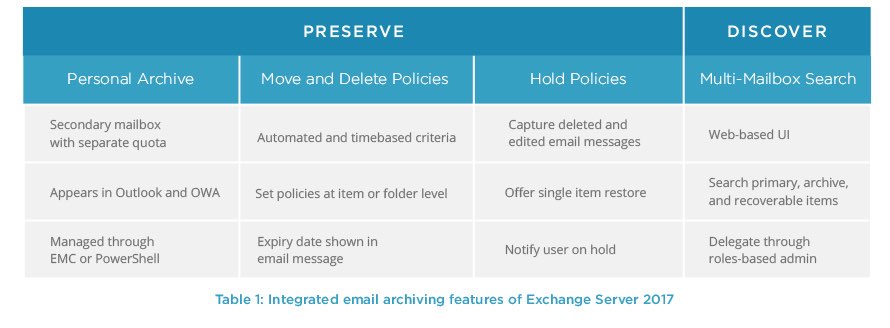Microsoft Exchange 2016, 2013 and 2010 Archiving: Native vs Third-party Solutions
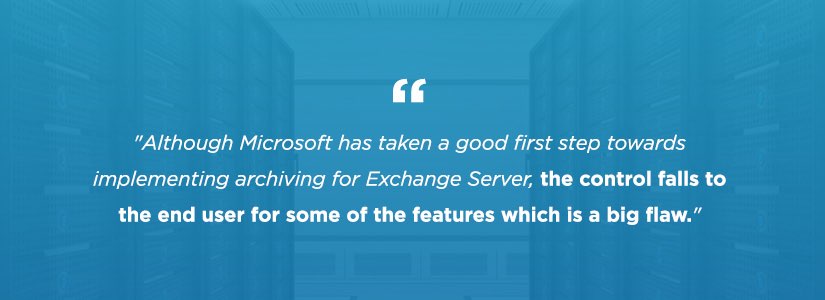
Exchange Server 2016, 2013 and 2010 archives emails natively but you really need a purpose built solution which satisfies the regulatory, legal and policy requirements of business.
If you have older Exchange Server you have no choice but to go with a third party email archiving solution.
You can download this full report on native vs. third-party solutions here.
Emails account for over ninety percent (90%) of business communication. These communications contain valuable business data like contracts, purchase orders, invoices, presentations, and others.
Because of the sensitivity and business value of the content numerous regulations have been enacted. They cover record protection, retention and discovery standards.
Apart from that, businesses also face other IT challenges because of growth of email data. The IT departments are struggling to meet the ever growing storage requirements while keeping their mail servers in optimal condition.
What are the Major Drivers to Archive Emails?
There are many motivations for implementing an email archiving solution. Some of the major ones are:
- Regulatory Compliance
- Litigation and eDiscovery (Legal Discovery)
- Data Preservation and Intellectual Property Protection
- Email Server and Storage Optimization
- Email Server Backup and Disaster Recovery
- Monitoring Email Communication Content
Microsoft Exchange Native Email Archiving and Discovery Capabilities
Recognizing the importance of archiving solutions, Microsoft introduced out-of-the-box email archiving, retention and discovery capabilities with its Exchange Server 2010 and improved these capabilities with Exchange Server 2013 and 2016.
Archiving
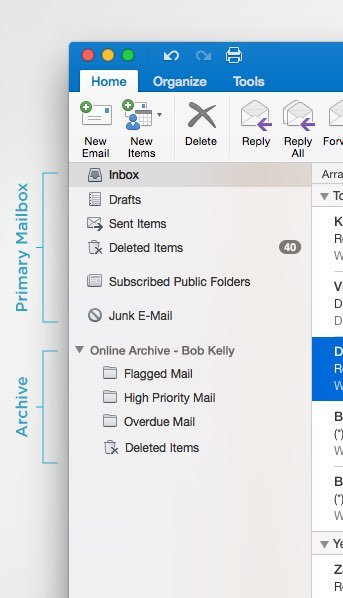
- First, utilizing large mailbox where users don’t have to delete any emails.
- Second, utilizing Personal Archive which is a specialized, secondary Exchange mailbox associated with a user’s primary mailbox.
Users are responsible for managing their own archiving needs by moving the email from the primary mailbox to the Personal Archive.
Retention
Retention rules can be set by users or by the IT department. As email moves from primary mailbox to the Personal Archive different rules can apply – like move emails from primary mailbox after 90 days to the Personal Archive or move emails to subfolder in Personal Archive after 180 days or move emails from subfolder to deleted items after 180 days. And finally, permanently delete emails from Exchange.
IT can build default rules and end users can modify them according to their own needs. A default rule is applied if a rule does not exist for a particular folder.
Discovery
Uses can search their own Personal Folders and work with any email just like it is in the primary mailbox. Web-based UI is provided for the specialized users like compliance officers who are responsible for searching and discovery. Role-based multi-mailbox searching is also available to these users.
Legal Hold
Legal hold can be placed on any mailbox which will stop an end user from editing or deleting any email in primary or Personal Archive. A user is notified that a legal hold has been placed on their mailbox. Legal hold can be placed on an individual mailbox or across the enterprise for a specific time period, for example, legal hold can be placed for next 180 days.
Limitations of Native Exchange Archiving
Although Microsoft has taken a good first step towards implementing archiving for Exchange Server, the features needs refinement. The control falls to the end user for some of the features which is a big flaw when implementing archiving from a regulation point of view.
i. Archiving Limitations
The archiving policy decisions should be made on the corporate level. Best practice is to archive all the incoming and outgoing email across the enterprise. The decision which email to archive and which should be deleted should not be given to the end user.
- First, users have to make a judgment call on each email which will take time.
- Second, they might delete emails which should be saved.
Usually the end user will lose or delete an email and then ask the IT department to recover it. With Exchange archiving the email the problem still persists. The email will not be found, as it never made it to the archive. This defeats the whole purpose of archiving.
ii. Retention Limitations
Retention policies should be made on the corporate level. Depending on the government and industry regulations, a corporation needs to implement an enterprise wide retention policy.
All users don’t have the knowledge or understanding about the ever changing regulatory requirements of the corporation and shouldn’t be burdened to make a judgment call on how long to retain the email.
Best practice is to involve legal and compliance departments in devising these policies and then implement them across the enterprise.
iii. Discovery Limitations
Role based multi-mailbox is a must, although Exchange archive provides this capability but with limited functionality. The two main reasons for discovery is legal or information request. In both case. content should be in a share-able format.
In litigation the emails could be part of proceedings and need to be submitted in the court. An information request means that the emails need to be provided to some entity outside of the company. Exchange archive does not provide a tool to share the content after it is discovered.
iv. Legal Hold Limitations
In Exchange archiving legal hold can be placed on one or more mailboxes. The users are notified that a hold has been placed on their mailbox and Personal Archive. Users should never be notified that a legal hold has been placed on their emails.
A company can investigate an employee on insider trading and place a legal hold on the mailbox. As soon as the legal hold information is available to the users they will know something is wrong. It is no stretch of imagination that a sharp decline in email communication will be the immediate result. Also, the employee will spend time figuring out why the legal hold is placed and the productivity will go down.
In short, legal hold falls into a need-to-know basis and only concerned authorities should see it.
Shortcomings of Native Exchange Archiving
Microsoft has rolled out archiving with features which have limited capabilities. As of the latest release of Exchange 2016, there are necessary features which are missing from the offering.
Some of the key features which an archiving solution should have are discussed below.
i. Audit log
To satisfy the strict standards of regulatory compliance it is essential that audit logs are kept for all the actions taken by users. This is an important feature because compliance officers, human resource managers and legal counsel will conduct discovery on sensitive content.
Audit logs will ensure that proper care was taken while doing discovery, which content was viewed, how and to whom it was shared with.
ii. Tags and comments
Part of a discovery request requires that each email is viewed and appropriate action taken. An email could be found during discovery phase but it might not be directly related to the issue at hand. This email will not be shared.
Tag and comment features give corporations tools to ensure an appropriate reason is documented why an email is –or is not—part of the final selection.
Tags are also used for process flow. “To be reviewed” tag can be placed on all the email found during discovery. A “reviewed” tag can be placed once each email is viewed. With tagging, each department will know which queue is theirs and requires their attention.
iii. Monitoring
It is a requirement to review some or all email content. A random search feature accommodates for this type of requirement. Every night all emails go through the filter and a select percentage are automatically selected for further review.
iv. Automation
Automatic classification of email content is becoming a necessary tool for corporations because of the share number of emails going through their email servers. An email archiving solution needs to provide a simple and easy way to classify the emails and notify the concerned authority.
Technical drawback of Native Exchange Archiving
First problem is the server bloat. Exchange Server admins are required to maintain their email server running optimally. They have limited amount of processing power and disk storage. The email server functions efficiently as long as processing power and disk space utilization are in balance. As the mail stores grow in size it takes an email server longer to complete a task like sending or receiving the emails, loading the mailbox, etc. This is called storage bloat. Traditionally, email server administrators have placed a mailbox quota to reign in the uncontrolled storage growth.
Second problem are the important business content which resides outside the email server and into the Microsoft Outlook Data Files (.PST file). Businesses are generating an ever-increasing amount of valuable information through email. The need for larger mailboxes is also increasing. When mailbox quota are implemented users save their email in PST file, removing these important content from Exchange Server.
i. Unmanageable Storage Growth
The PST files are not bad in themselves, the problem is when the emails are in the PST files they are out of control of the IT. These files are not backed up. They are missing when a discovery request arrives. The retention policy or legal host cannot be placed on them. On top of them they get corrupted and IT has to figure out how to extract important emails out of them. Hence IT professional call this a “PST hell” problem.
The solution provided by Microsoft Exchange archive is to import the PST files into Personal Archive Folders. This solves the problem in theory, but the cost is the unmanageable growth and price of storage. As mentioned earlier, the first problem the email administrators are trying to solve is the storage bloat. Native Exchange archiving exacerbates this problem instead of solving it.
ii. Lack of Single-Instance Email
Because of architectural decisions made for higher availability and better performance, multiple instances of email and attachment have to be saved by Exchange Server. This is one of the major reasons the Exchange storage growth will become unmanageable very quickly.
An email archive solution should not only do single-instance of email but should also de-duplicate the attachments. For example, the company logo which is part of the signature of all the company’s emails should be stored only once. It shouldn’t be stored with all the emails.
Email Archiving for Exchange 2007, 2003 and older
Around 12% of corporations have Exchange Server 2007 or older as their email server. A third party solution is the only option for these corporations. Slowly these companies are migrating to the newer email server.
No Native Email Archive
Microsoft Exchange Server 2007, Exchange Server 2003 and older do not have native email archive features. These Exchange servers also provide a journaling feature which is used by most of the third party email archive solutions. Copies of all the incoming and outgoing emails are placed into the journal mailbox.
The archive solution will connect to this mailbox and archives all the emails. Once the emails are on the solution they are removed from the journal mailbox.
Why You Need Purpose-Built Email Archiving Solution
Microsoft Exchange is a leading email server in the corporate world. It accounts for 51% of worldwide mailboxes in the Business Email and Collaboration market. Exchange 2016 is the top deployment in the exchange family.
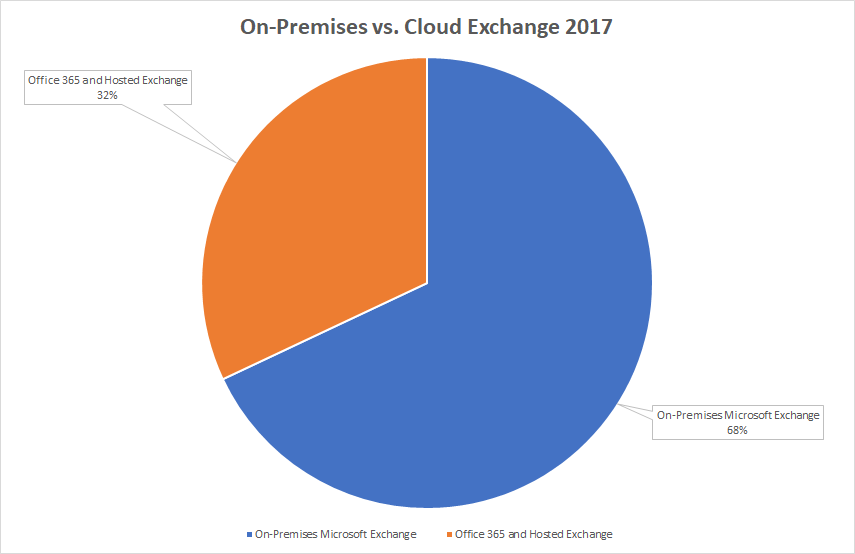
Some of the important features and benefits are described below.
- Email Sever Storage Management – Email server should not be burdened to hold email. The emails should be received on the archive solution as soon as they are in the journal mailbox. Once they are processed they should be removed from the email server.
- Optimized Disk Utilization – A well thought out local disk management system is an integral part of the solution. A solid de-duplication technology ensures that most –if not all– documents are captured for de-duplication. All emails and their parts are de-duplicated. What this means is that an attached presentation which is sent around by multiple people in a company is only stored once on the archive system.
- Email Record Preservation – The primary purpose of the archive solution is preservation of emails. The golden standard for storing an email is that it is permissible in the court of law. This will ensure that email archive solution will pass any industry audit and will be compliant with regulations.
- Easy, Complete and Intuitive Tags and Comments – Business users need a complete tagging and commenting process which is customizable according to their requirements. Ease of use is important for this feature. The same task which needs to be performed daily or periodically is automated.
- Search Exclusion Capability – Search exclusion is the ability to omit certain email addresses from being searched. These could be anything from the email address of the CEO to legal counsel.
- Advanced Search for Power User – Human Resources and Legal departments require a robust and powerful search interface. There are times when the human resource department has to find one email out of millions which is in question. This requires a complex search criterion. Advanced search interface needs to be powerful at the same time it should be easy to use and intuitive.
- Automatic Mailbox Management – An email archive solution should supplement email servers to run efficiently and optimally, by managing major portion of email content. A simple mailbox quota ensures that email content load does not increase on email server over time.
- Seamless End User Experience – A seamless end user experience is necessary for any email archive deployment. A native plug-in for MS Outlook is imperative. The look and feel of the plug-in should be similar to the Outlook environment. End users should be able to find the emails they are looking for without the help of IT or even reading help files.
- Simple, Elegant and Powerful Electronic Discovery (eDiscovery) – Litigation and eDiscovery, the pre-trial phase of a lawsuit, can quickly become a reality for IT and legal departments. When it happens a simple, elegant and powerful solution is needed. Time is of essence at this stage, relevant email needs to be found quickly and a legal hold placed on them if necessary.
- Email Classification and Retention Policies – The archive solution should have a granular retention policy. Automatically classify emails –like spam, legal, contracts, etc.—accordingly and remove from the disk periodically. Lifetime management of emails dictates that due care is being taken at each stage from first capturing to eventually destroying once a retention policy has been reached.
- Sampling for Review – In many industries a sampling of emails has to be reviewed. The solution should provide an automated way to randomly select the emails and place it in the queue to be reviewed. This is sometimes a daily task; any step which is automated will save valuable business time.
- Messaging Intelligence – Let big data work for your business. There is valuable business insight hidden in email content and relationships. Messaging intelligence can help in a pre-trial phase for legal; help understand the relationships between sales and customers, and much more. This is a new feature which was not available in the earlier versions and archiving solutions are just beginning to realize the potential of email content.
- Full Audit Trail – Any and all actions taken in the archive solution should be captured and stored. This is available to the power users as read-only. This ensures the integrity of the solution.
- Groups and Department – Integration between Active Directory and archive solution is necessary. This will assist separation of duties based on departments already maintained in the active directory.
- Role Based Permission – Role based permission is necessary for any email archive solution. Different departments have different requirements. Role based permission will ensure that appropriate features are available to each individual in a given department.
- Export and Sharing – There are many reasons for exporting and sharing. The one obvious reason is in case of litigation. After finding the desired emails they need to be exported and shared –within or outside—of the company.
- Exchange Migration – Email archiving solutions are not usually seen as part of Exchange migration projects. In fact they can benefit the corporation tremendously by first capturing all the emails from the older unit and having the emails available to the end users during a migration project.
- PST Import – PST files contain valuable business content that are outside the control of IT. An email archiving solution should have a way to get these emails imported into the system. This will ensure that all the email content of the corporation is centrally archived and managed according to the corporate policies.
Conclusion
Microsoft Exchange Server provides solid email infrastructure but their email archive capabilities are not business ready. As you can see for the above discussions that there are still many business features which are missing or not mature enough to perform well in the business environment.
A purpose built email archiving solution is better suited to meet today’s business, compliance and regulatory requirements.
